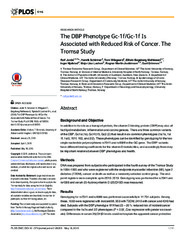The DBP Phenotype Gc-1f/Gc-1f is associated with reduced risk of cancer. The Tromsø Study
Permanent link
https://hdl.handle.net/10037/8653Date
2015-05-18Type
Journal articleTidsskriftartikkel
Peer reviewed
Author
Jorde, Rolf; Schirmer, Henrik; Wilsgaard, Tom; Mathiesen, Ellisiv B.; Løchen, Maja-Lisa; Joakimsen, Ragnar Martin; Grimnes, GuriAbstract
Methods DNA was prepared from subjects who participated in the fourth survey of the Tromsø Study in 1994-1995 and who were registered with the endpoints myocardial infarction (MI), type 2 diabetes (T2DM), cancer or death as well as a randomly selected control group. The endpoint registers were complete up to 2010- 2013. Genotyping was performed for rs7041 and rs4588 and serum 25-hydroxyvitamin D (25(OH)D) was measured.
Results Genotyping for rs7041 and rs4588 was performed successfully in 11 704 subjects. Among these, 1660 were registered with incident MI, 958 with T2DM, 2410 with cancer and 4318 had died. Subjects with the DBP phenotype 1f/1f had 23 – 26 % reduced risk of incident cancer compared to the 1s/1s and 2/2 phenotypes (P < 0.02, Cox regression with gender as covariate). Differences in serum 25(OH)D levels could not explain the apparent cancer protective effect of the DBP variant 1f. In addition to cancer and 25(OH)D, there were significant associations between DBP phenotype and body height, hip circumference and serum calcium.
Conclusion There are important biological differences between the common DBP phenotypes. If the relation between the DBP variant 1f and cancer is confirmed in other studies, determination of DBP phenotype may have clinical importance.


 English
English norsk
norsk